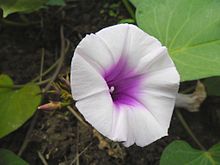Sweet potato
| Sweet potato | |
|---|---|
 |
|
| Sweet potato in flower in Hong Kong | |
 |
|
| Sweet potato roots | |
| Scientific classification | |
| Kingdom: | Plantae |
| (unranked): | Angiosperms |
| (unranked): | Eudicots |
| (unranked): | Asterids |
| Order: | Solanales |
| Family: | Convolvulaceae |
| Genus: | Ipomoea |
| Species: | I. batatas |
| Binomial name | |
|
Ipomoea batatas (L.) Lam. |
|
| Nutritional value per 100 g (3.5 oz) | |
|---|---|
| Energy | 359 kJ (86 kcal) |
|
20.1 g
|
|
| Starch | 12.7 g |
| Sugars | 4.2 g |
| Dietary fiber | 3 g |
|
0.1 g
|
|
|
1.6 g
|
|
| Vitamins | |
| Vitamin A equiv. |
(89%)
709 μg
(79%)
8509 μg |
| Thiamine (B1) |
(7%)
0.078 mg |
| Riboflavin (B2) |
(5%)
0.061 mg |
| Niacin (B3) |
(4%)
0.557 mg |
| Pantothenic acid (B5) |
(16%)
0.8 mg |
| Vitamin B6 |
(16%)
0.209 mg |
| Folate (B9) |
(3%)
11 μg |
| Vitamin C |
(3%)
2.4 mg |
| Vitamin E |
(2%)
0.26 mg |
| Minerals | |
| Calcium |
(3%)
30 mg |
| Iron |
(5%)
0.61 mg |
| Magnesium |
(7%)
25 mg |
| Manganese |
(12%)
0.258 mg |
| Phosphorus |
(7%)
47 mg |
| Potassium |
(7%)
337 mg |
| Sodium |
(4%)
55 mg |
| Zinc |
(3%)
0.3 mg |
|
|
|
|
|
| Percentages are roughly approximated using US recommendations for adults. Source: USDA Nutrient Database |
|
| Nutritional value per 100 g (3.5 oz) | |
|---|---|
| Energy | 378 kJ (90 kcal) |
|
20.7 g
|
|
| Starch | 7.05 g |
| Sugars | 6.5 g |
| Dietary fiber | 3.3 g |
|
0.15 g
|
|
|
2.0 g
|
|
| Vitamins | |
| Vitamin A equiv. |
(120%)
961 μg |
| Thiamine (B1) |
(10%)
0.11 mg |
| Riboflavin (B2) |
(9%)
0.11 mg |
| Niacin (B3) |
(10%)
1.5 mg |
| Vitamin B6 |
(22%)
0.29 mg |
| Folate (B9) |
(2%)
6 μg |
| Vitamin C |
(24%)
19.6 mg |
| Vitamin E |
(5%)
0.71 mg |
| Minerals | |
| Calcium |
(4%)
38 mg |
| Iron |
(5%)
0.69 mg |
| Magnesium |
(8%)
27 mg |
| Manganese |
(24%)
0.5 mg |
| Phosphorus |
(8%)
54 mg |
| Potassium |
(10%)
475 mg |
| Sodium |
(2%)
36 mg |
| Zinc |
(3%)
0.32 mg |
|
|
|
|
|
| Percentages are roughly approximated using US recommendations for adults. Source: USDA Nutrient Database |
|
The sweet potato (Ipomoea batatas) is a dicotyledonous plant that belongs to the morning glory family Convolvulaceae. Its large, starchy, sweet-tasting, tuberous roots are a root vegetable. In some parts of the English-speaking world, sweet potatoes are locally known by other names, including "yam" and kumara. The young leaves and shoots are sometimes eaten as greens. The sweet potato is only distantly related to the potato (Solanum tuberosum) and does not belong to the nightshade family Solanaceae, but that family is part of the same taxonomic order as sweet potatoes, the Solanales.
The plant is a herbaceous perennial vine, bearing alternate heart-shaped or palmately lobed leaves and medium-sized sympetalous flowers. The edible tuberous root is long and tapered, with a smooth skin whose color ranges between yellow, orange, red, brown, purple, and beige. Its flesh ranges from beige through white, red, pink, violet, yellow, orange, and purple. Sweet potato varieties with white or pale yellow flesh are less sweet and moist than those with red, pink or orange flesh.
Ipomoea batatas is native to the tropical regions in the Americas. Of the approximately 50 genera and more than 1,000 species of Convolvulaceae, I. batatas is the only crop plant of major importance—some others are used locally (e.g. I. aquatica "kangkong"), but many are poisonous. The genus Ipomoea that contains the sweet potato also includes several garden flowers called morning glories, though that term is not usually extended to Ipomoea batatas. Some cultivars of Ipomoea batatas are grown as ornamental plants under the name tuberous morning glory, used in a horticultural context.
...
Wikipedia
